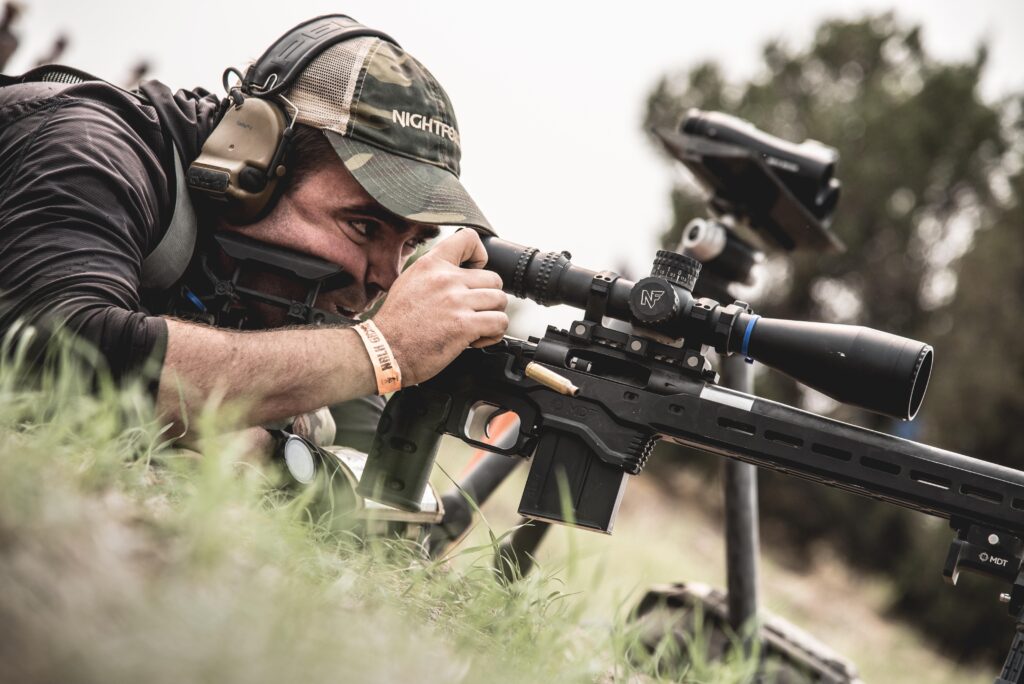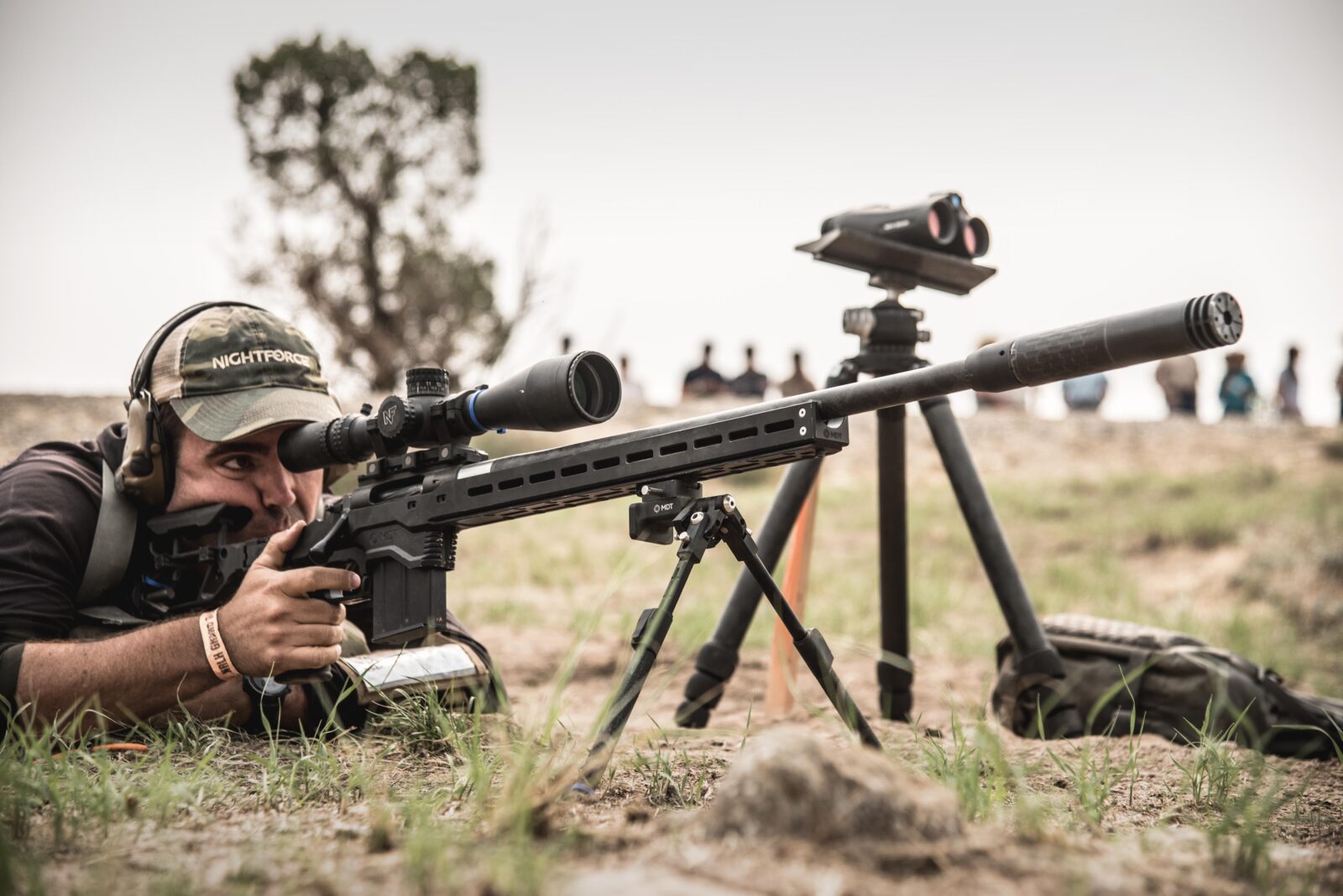With the NRL Hunter Grand Slam just wrapping up, we are going to explain a little bit about this exciting new shooting sport.
Intro
The NRL Hunter series is the brainchild of Scott Satterlee. In 2020, the Hornady Precision Hunter Steel Challenge match ended up being a prototype for what is now a series of matches around the country. As the story goes, with a little convincing through a few drinks, Travis Ishida and the rest of the NRL crew setup the NRL Hunter series. For the first year, there were eight matches plus the finale event, known as the Grand Slam.
If you trace back to the origins of many field style competitions, you’ll find a healthy amount of hunters that were looking to improve their rifle skills. There are many hunters in the various precision rifle events, but the NRL Hunter series was created to maintain a focus on field skills that a hunter might use. Since there is a score and time component, it is still a gun game… however, finding, ranging and engaging the gray animal shaped targets in terrain is something that everyone agrees isn’t easy. In the professional rifleman field there are many versions of the statement “shooting is a small part of the job until it’s 100% of the job.” That quote remains true for the hunter. As hunters we want to make clean, ethical shots on game animals, so marksmanship is still a big deal. The added challenge of finding and ranging the targets translate to necessary functions when you’re on a hunt.
Stage Design
There are essentially three types of stages to the NRL Hunter matches: one target, two target and four target varieties. All stages are four minutes in length.
A single target stage will have one target, but engaged from four different positions. This can mean a bit of movement depending on the terrain.
A two target stage will have two targets, but engaged from two positions.
A four target stage will have four targets, but engaged from a single positions. Finding four targets is generally a little harder depending on how far apart the targets are spaced.
Shooting Stages
Before you shoot, a “stage brief” is located at the start position or staging area. On here is the target shape, number of targets and any sequencing information. This is important because there is no prior knowledge of target locations and depending on the terrain/location, you might not even see the shooting area at all. When it’s time to shoot, the RO will ask if you’re ready and then your four minutes of fury starts.
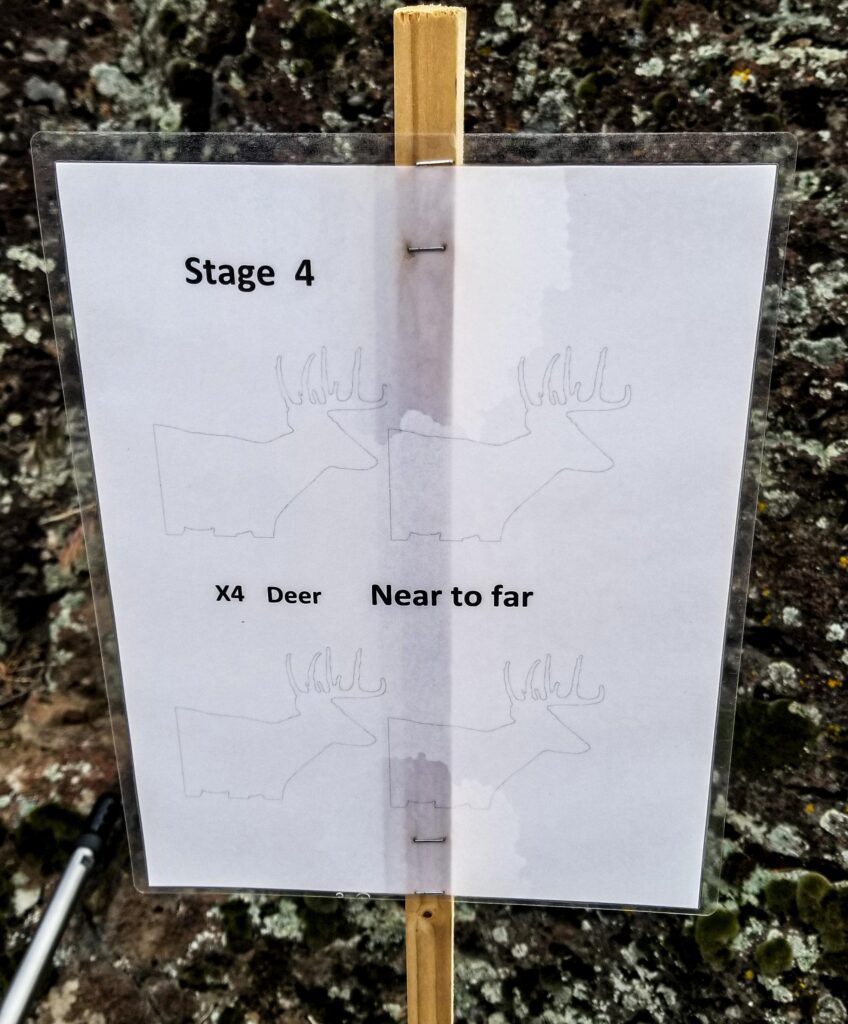
So how does the rest of the stage flow? Remember the phrase find, range and then engage. First you have to find the target(s). The first target will have a placard with the stage number at a close distance to the first target. At the shooting position there are a couple stakes giving orientation to the target or with left/right limits to look. Pro-Tip, if you can find the placard by eye as you get into position it gives you a good head start on where to look.
Once you find the placard, the targets will be located in a near-to-far or left-to-right format (identified before you start the stage). Some shooters choose to find all of the targets and then start shooting, while others might shoot as they find the targets. As targets have to be engaged in order, finding them all first is generally a good idea.
After they are found, getting the range to target is necessary. A rangefinder is essential for this. Once ranges are obtained, you can either memorize the distances or write them down somehow. If you have a rangefinder that has a ballistic system built-in, you can cut out the distances and go straight to the drop data. Even though my rangefinders have ballistics, I still prefer to get the yardages to double check what I’m seeing makes sense regarding ranges.
Finally it’s time to shoot some steel. Each engagement has two opportunities, but if you hit your target on the first shot you move to the next engagement. Once you engage all of the targets you’re done…or however far you get in four minutes.
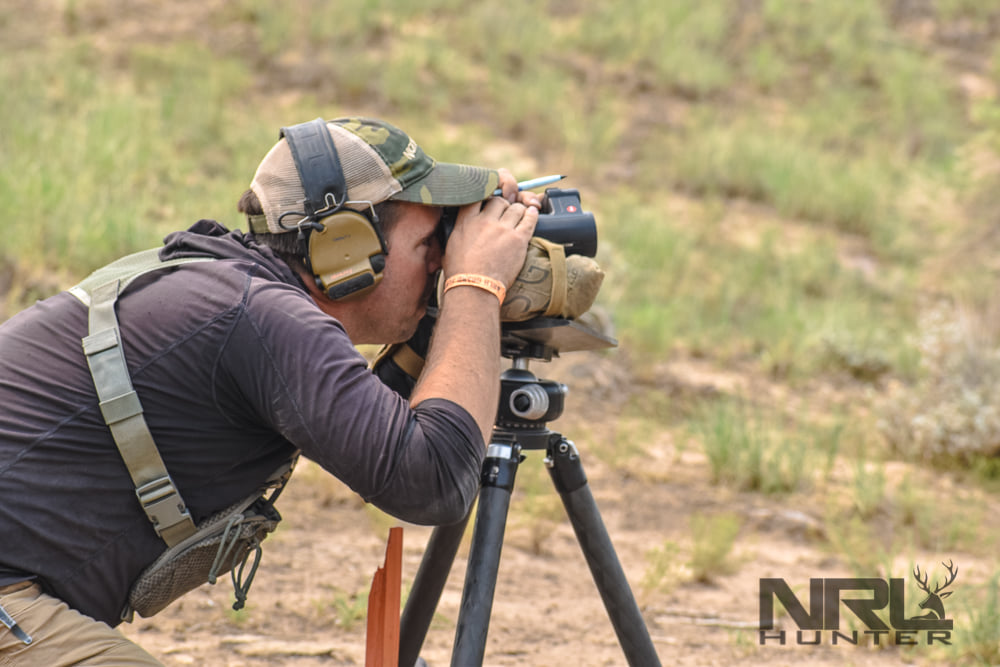
Scoring
Each stage of the NRL Hunter series has a maximum of eight points available. Every target is allowed two attempts, rewarding a first round hit with two points. Should a shooter miss, they can attempt again for a single point. A “clean” run would be firing only four shots total per stage.
This 2-1 “dead target” scoring works really well for a hunter series, by rewarding the first-round hit. It also helps reduce the round count when using hunting rifles, by not overheating a rifle with a lot of shots.
Divisions
Being a hunter series, there were three divisions with varying requirements as well as a minimum power factor. This made sure the rifles were competitive but not 25-30lb monsters. The divisions were as follows (with rules straight from NRL):
- Factory
- Factory is described as completely original from the factory configuration any SKU, from the following list, as long it is unmodified in any way and under 12 lbs.
- Acceptable SKUs: Barrett, Bergara, Berretta, Browning, Christensen Arms, Colt, Fierce, FN, Henry, Howa, Kimber, Marlin, Mauser, Mossberg, Nosler, Remington, Ruger, Sako, Savage, Seekins, Sig Sauer, Smith & Wesson, Springfield, Steyr, Thompson, Tikka, Victrix, Weatherby, Winchester.
- Muzzle Breaks: only if the original SKU has a threaded muzzle. Anything else that is a bolt on attachment is fine, but must be on the rifle at the time of weigh in.
- Open Light
- Open Light will be 12 lbs. maximum.
- No restrictions on gear, equipment attached, build, or configuration, as long as it is under the prescribed weight for this class.
- Open Heavy
- Open Heavy will be 16 lbs. maximum.
- No restrictions on gear, equipment attached, build, or configuration, as long as it is under the prescribed weight for this class.
All of the divisions had a minimum power factory. This again ensured a competitive field, but also that the rifles would be in legitimate big game hunting cartridges. Essentially the floor was established at a 6.5 Creedmoor, and if you do the math the heavier the bullet the easier it is to meet the power factor. For example a 130gr bullet needs to be 2923 fps, while a 140gr bullet needs to be traveling 2714 fps, while a 150gr bullet only has to be going 2533 fps.
Per NRL:
Minimum Power Factor (PF) is 380,000. The Bullet Weight in (gr) multiplied by Muzzle Velocity in (fps). For example, 143 gr @ 2670 fps = 381,810 and makes the minimum. With a Muzzle Velocity maximum of 3275 fps 6mm with 115gr will not be able to make the minimum PF.
Additionally, a rules amendment was made for factory ammo usage, which opens up more options to shooters…particularly if the rifle has a shorter barrel.
A competitor that is using MASS PRODUCED COMMERCIALLY AVAILABLE ammunition (such as Federal Ammunition) in caliber .257 or larger and 120 grain bullet or heavier will be exempt from the power factor and will still be able to obtain season points and placement for the Grand Slam. Reloaded ammunition or custom commercially available ammunition will be required to make power factor in ALL classes.
1. Mass Produced = can be purchased at Cabela’s, Bass Pro or the local large chain retail sports stores
2. Custom commercially available ammunition = loaded by hand to the owners specifications or only available through a direct order from the specific manufacturer.
3. The Competitor will have to identify what ammunition they are shooting at the match during sign ups by the manufacturer and provide a lot number. All ammunition must be in its original sealed boxes.
4. The ammunition will be checked at sign up and randomly during the COF.
For the matches that I shot in 2021, I competed in the Open Heavy division. I didn’t shoot the same rifle each time, instead adapting heavier chassis guns to save weight. For example a chassis rifle with weights stripped out and something like a medium palma contoured barrel or a Proof Research carbon-fiber wrapped barrel would cut the weight to the 16lb minimum. With some of the specialized light-weight chassis or a carbon-fiber shelled stock, hitting the 12lb limit becomes much easier.
Partly due to parts availability for new builds and also to play with versatility, I ended up shooting normally heavier guns stripped to make weight. At the Tennessee match I shot a Surgeon in a RACS chassis with a carbon-fiber wrapped barrel, at the Idaho match I shot my Accuracy International AX with a medium palma barrel, and for the finale I shot an MDT ACC equipped TL3 with another carbon-fiber wrapped barrel. I did shoot a 6.5 Creedmoor with either 140gr ELD-Ms or 135gr A-Tips.

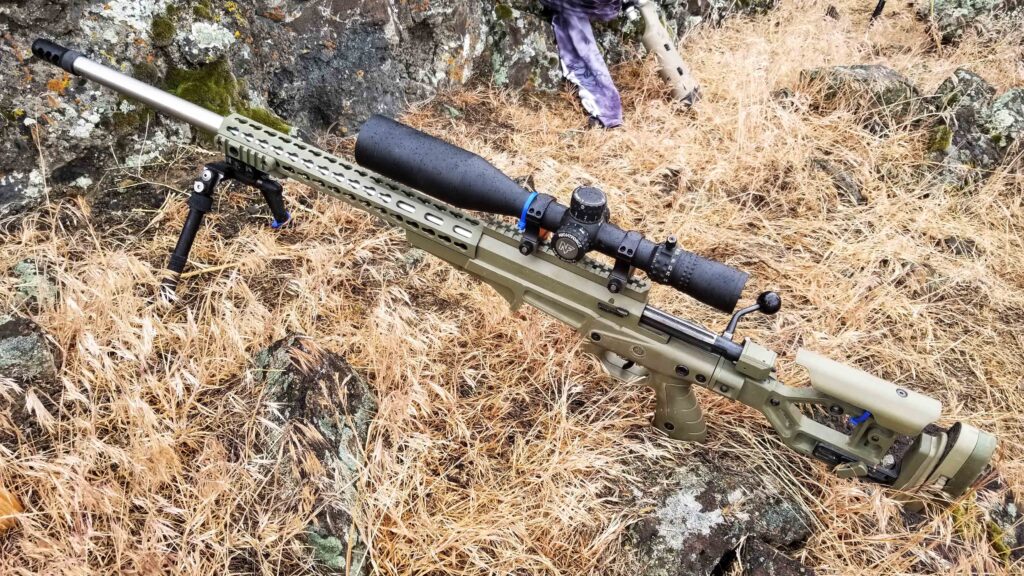

Essential Gear
There are a few essential items aside from a rifle and ammunition that complies with one of the divisions.
- Binoculars/Laser Rangefinder – Having some means of locating targets is essential, and the most popular way to do that is with binoculars. Next, the target distance must be obtained. Since target sizes aren’t provided, a laser rangefinder is needed here. If you can afford to combine the two and get LRF equipped binoculars you’re going to save quite a bit of time. For a budget friendly option, the Vortex Fury HD 5000s are a solid option. If you want premium glass, I like the Leica HD-B 3200.coms, or the Swarovski EL-Range 10x binos.
- Data Management – whether you use an onboard ballistic calculator or like to have a range card, some means of capturing/storing this information for use on the stage is important. For a single target, this is pretty easy. With four targets this can keep you straight. I like to run an armboard with my data underneath, then use a wet-erase marker to record information.

- Support Bag – Between prone shooting (using a rear bag) or shooting off of natural terrain, a support bag or two can be very helpful. Something like an Armageddon Gear Gamechanger, Thunderbird Bone Bag or Wiebad Fortune Cookie would all work. The key is to be able to adapt it to the situation at hand. With the lighter rifles, I also like using a bigger rear bag to fill space in natural terrain. Also if you want to save a little weight, I highly recommend the Git-Lite fill to cut a 10-lb bag to two pounds.
- Tripod – most of the time a tripod is not needed for shooting. However when finding and ranging targets, the tripod can be extremely beneficial. Whether clipping in direct, using a support bag or shooting table, the stability provided by the tripod makes target identification much easier and your ranging more accurate. At the Idaho match I used the tripod a fair amount for shooting, but only used it for a stage or two as rear support at the Grand Slam. A tripod isn’t essential, but it is greatly beneficial.
- Gear Plan – while not a piece of gear, having some plan and way to manage all of your gear on a stage is important. Most people have a backpack to carry things for the day. Knowing how to get in and out quickly (since everything has to be deployed on the clock), and not make a yard-sale while doing it is essential. I also like to use a Hill People Gear chest bag to keep my binos handy and quickly drop stuff in from a stage.
Final Thoughts
The NRL Hunter series had a successful first season. At each of the three events I attended, everyone was excited for the future of this shooting sport. Being able to find, range and engage on your own are essential shooting tasks that anyone with a rifle should be able to do. Some of the gun games today have made it easy to forget or not even learn how to do the finding and ranging. As a hunter myself, I appreciate the practice trying to find hard to see targets in natural terrain.
With a focus on hunting rifles, the game has been setup to allow anyone to bring their hunting rig and have a chance at success. While I might hunt with a little heavier rifle than some, two of the three rifles I shot this year have been used on hunts. For others that might not be as into hunting, the individual skills practice of finding, ranging and engaging is also highly beneficial for some professional duties, or those that shoot other competitions that have finding and ranging of the targets (like many team precision rifle matches).
Travis, Brittany and the rest of the NRL, plus the match directors all want you to give it a try. They’ve gone so far as to have loaner rifles available, and other shooters are always willing to help out with gear if you have an interest. To learn more check out the NRL Hunter website at: https://nrlhunter.org/
